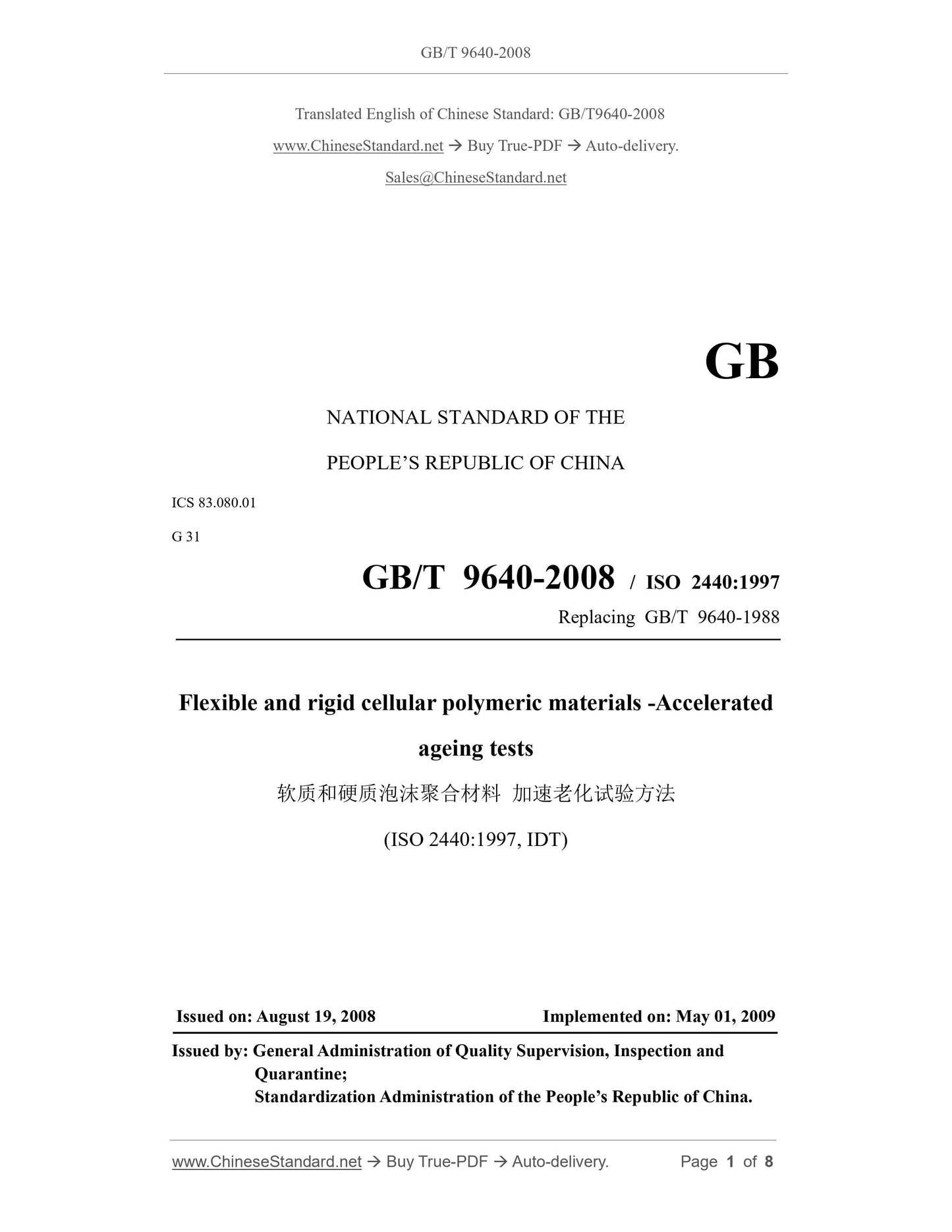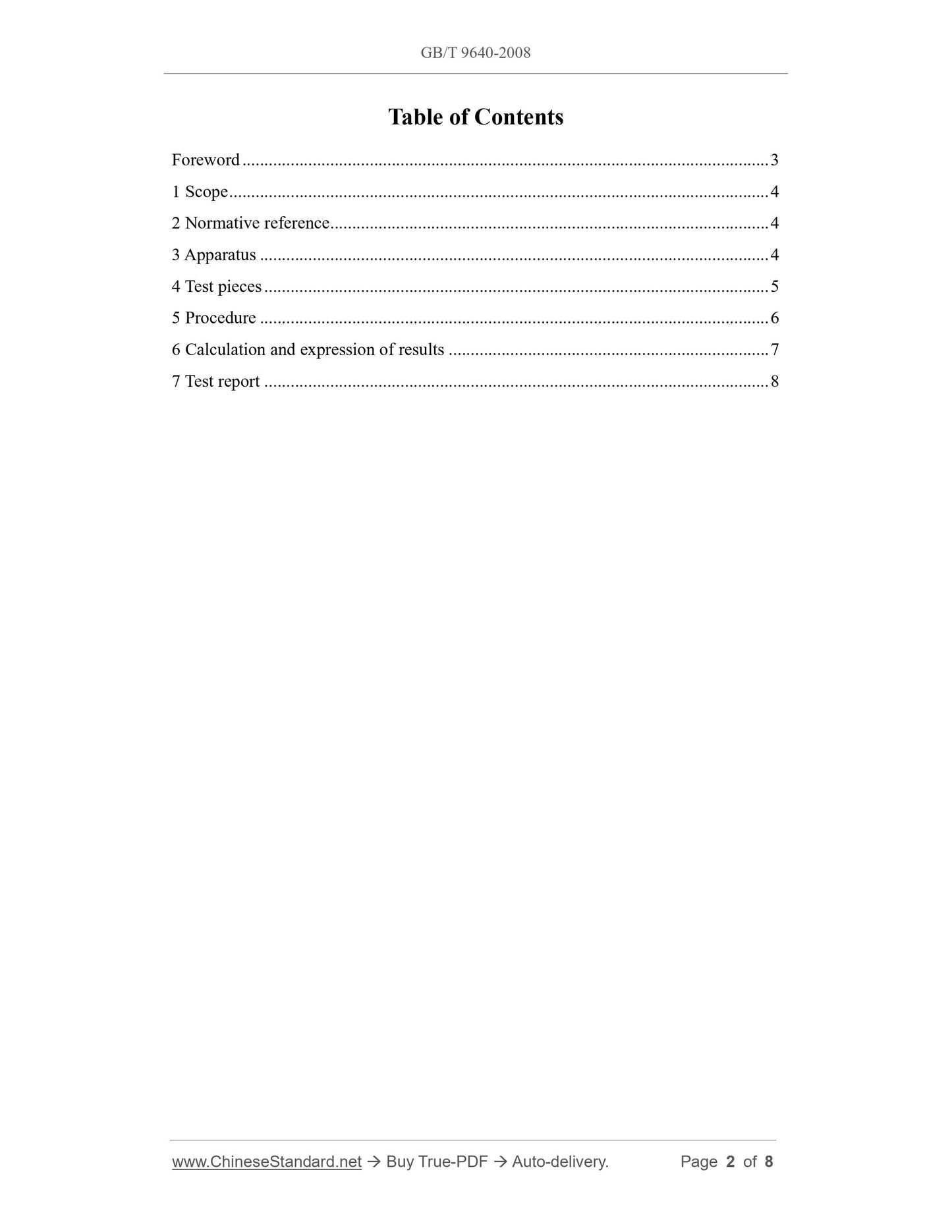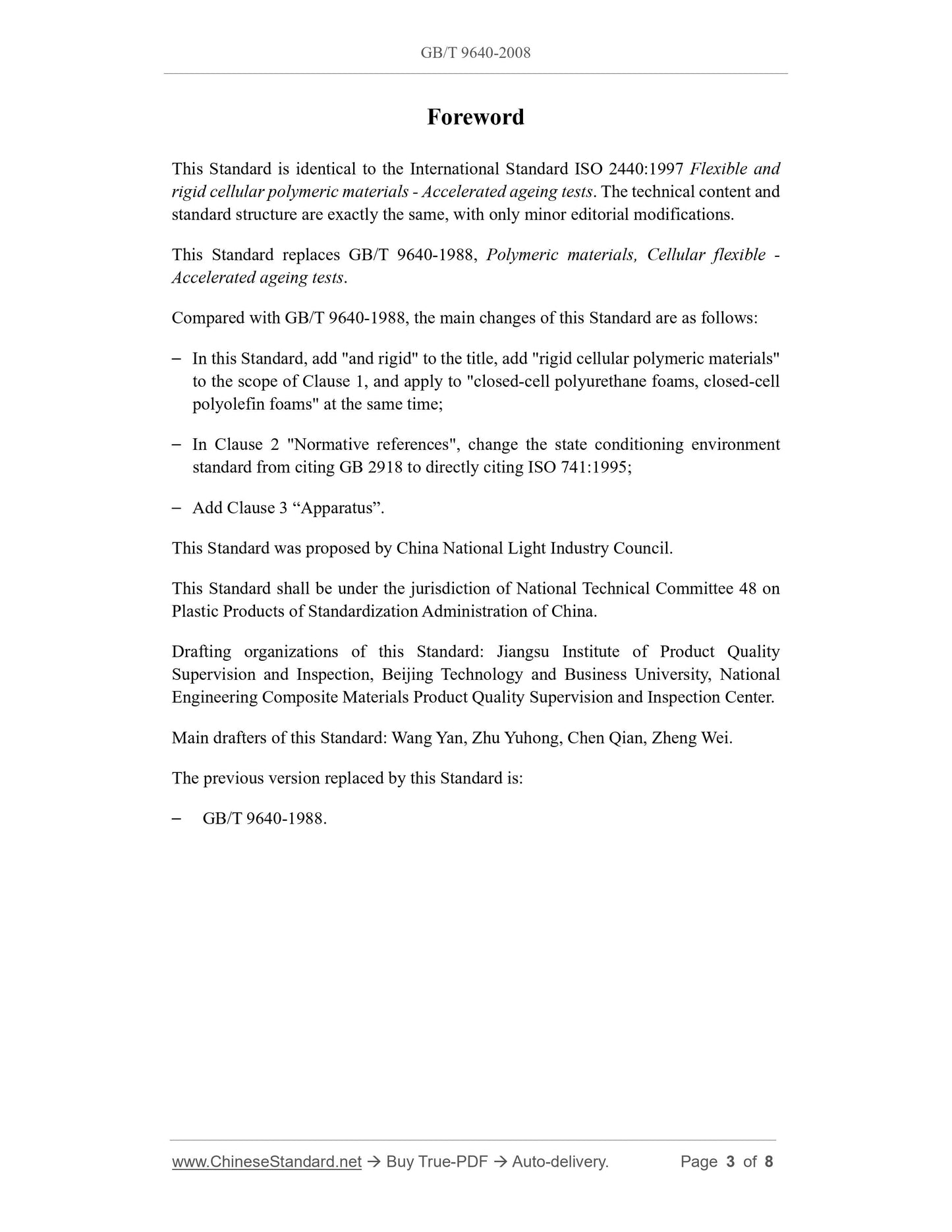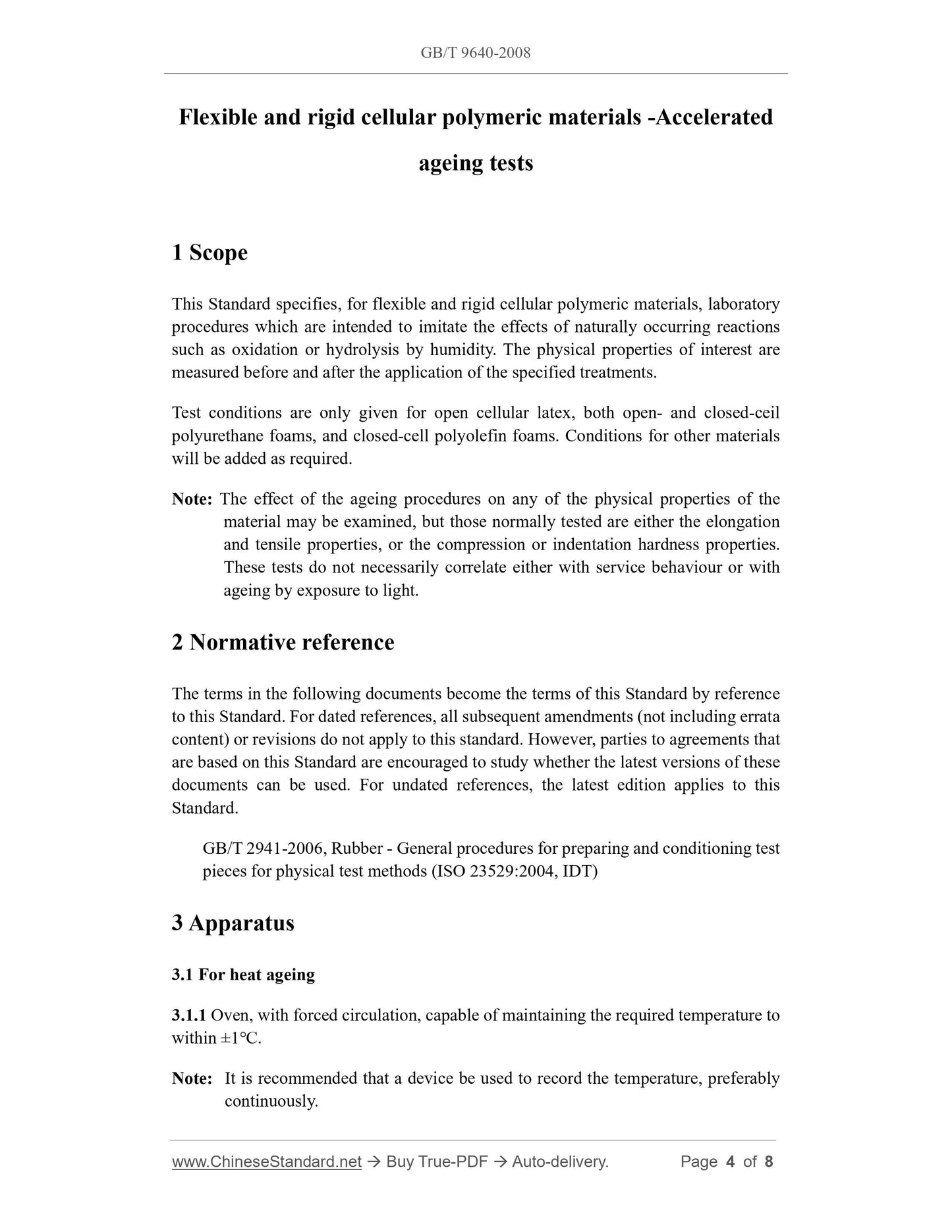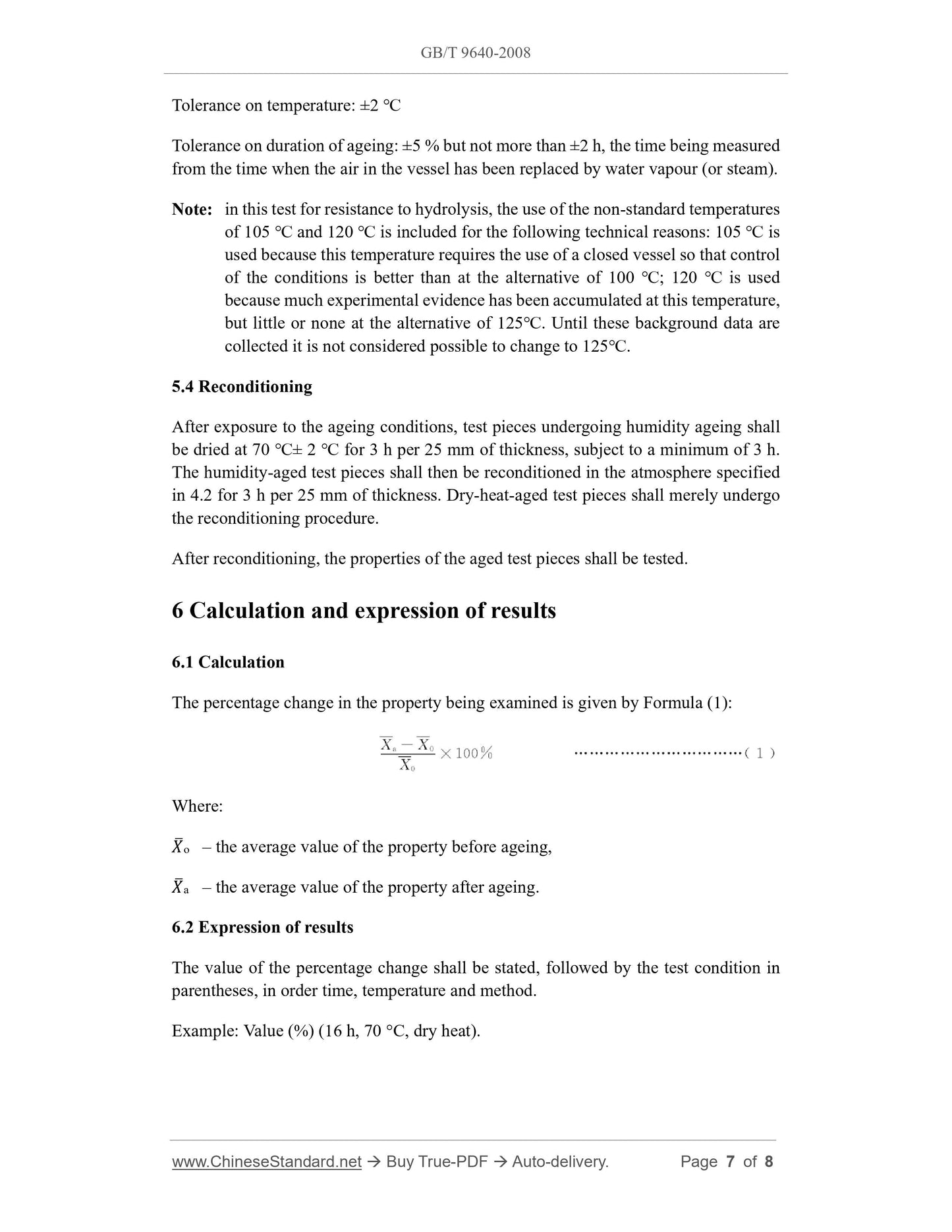1
/
의
5
PayPal, credit cards. Download editable-PDF and invoice in 1 second!
GB/T 9640-2008 English PDF (GBT9640-2008)
GB/T 9640-2008 English PDF (GBT9640-2008)
정가
$75.00 USD
정가
할인가
$75.00 USD
단가
/
단위
배송료는 결제 시 계산됩니다.
픽업 사용 가능 여부를 로드할 수 없습니다.
Delivery: 3 seconds. Download true-PDF + Invoice.
Get QUOTATION in 1-minute: Click GB/T 9640-2008
Historical versions: GB/T 9640-2008
Preview True-PDF (Reload/Scroll if blank)
GB/T 9640-2008: Flexible and rigid cellular polymeric materials -- Accelerated ageing tests
GB/T 9640-2008
GB
NATIONAL STANDARD OF THE
PEOPLE’S REPUBLIC OF CHINA
ICS 83.080.01
G 31
GB/T 9640-2008 / ISO 2440:1997
Replacing GB/T 9640-1988
Flexible and rigid cellular polymeric materials -Accelerated
ageing tests
(ISO 2440:1997, IDT)
ISSUED ON: AUGUST 19, 2008
IMPLEMENTED ON: MAY 01, 2009
Issued by: General Administration of Quality Supervision, Inspection and
Quarantine;
Standardization Administration of the People’s Republic of China.
Table of Contents
Foreword ... 3
1 Scope ... 4
2 Normative reference ... 4
3 Apparatus ... 4
4 Test pieces ... 5
5 Procedure ... 6
6 Calculation and expression of results ... 7
7 Test report ... 8
Foreword
This Standard is identical to the International Standard ISO 2440:1997 Flexible and
rigid cellular polymeric materials - Accelerated ageing tests. The technical content and
standard structure are exactly the same, with only minor editorial modifications.
This Standard replaces GB/T 9640-1988, Polymeric materials, Cellular flexible -
Accelerated ageing tests.
Compared with GB/T 9640-1988, the main changes of this Standard are as follows:
⎯ In this Standard, add "and rigid" to the title, add "rigid cellular polymeric materials"
to the scope of Clause 1, and apply to "closed-cell polyurethane foams, closed-cell
polyolefin foams" at the same time;
⎯ In Clause 2 "Normative references", change the state conditioning environment
standard from citing GB 2918 to directly citing ISO 741:1995;
⎯ Add Clause 3 “Apparatus”.
This Standard was proposed by China National Light Industry Council.
This Standard shall be under the jurisdiction of National Technical Committee 48 on
Plastic Products of Standardization Administration of China.
Drafting organizations of this Standard: Jiangsu Institute of Product Quality
Supervision and Inspection, Beijing Technology and Business University, National
Engineering Composite Materials Product Quality Supervision and Inspection Center.
Main drafters of this Standard: Wang Yan, Zhu Yuhong, Chen Qian, Zheng Wei.
The previous version replaced by this Standard is:
⎯ GB/T 9640-1988.
Flexible and rigid cellular polymeric materials -Accelerated
ageing tests
1 Scope
This Standard specifies, for flexible and rigid cellular polymeric materials, laboratory
procedures which are intended to imitate the effects of naturally occurring reactions
such as oxidation or hydrolysis by humidity. The physical properties of interest are
measured before and after the application of the specified treatments.
Test conditions are only given for open cellular latex, both open- and closed-ceil
polyurethane foams, and closed-cell polyolefin foams. Conditions for other materials
will be added as required.
Note: The effect of the ageing procedures on any of the physical properties of the
material may be examined, but those normally tested are either the elongation
and tensile properties, or the compression or indentation hardness properties.
These tests do not necessarily correlate either with service behaviour or with
ageing by exposure to light.
2 Normative reference
The terms in the following documents become the terms of this Standard by reference
to this Standard. For dated references, all subsequent amendments (not including errata
content) or revisions do not apply to this standard. However, parties to agreements that
are based on this Standard are encouraged to study whether the latest versions of these
documents can be used. For undated references, the latest edition applies to this
Standard.
GB/T 2941-2006, Rubber - General procedures for preparing and conditioning test
pieces for physical test methods (ISO 23529:2004, IDT)
3 Apparatus
3.1 For heat ageing
3.1.1 Oven, with forced circulation, capable of maintaining the required temperature to
within ±1℃.
Note: It is recommended that a device be used to record the temperature, preferably
continuously.
Tolerance on temperature: ±2 ℃
Tolerance on duration of ageing: ±5 % but not more than ±2 h, the time being measured
from the time when the air in the vessel has been replaced by water vapour (or steam).
Note: in this test for resistance to hydrolysis, the use of the non-standard temperatures
of 105 ℃ and 120 ℃ is included for the following technical reasons: 105 ℃ is
used because this temperature requires the use of a closed vessel so that control
of the conditions is better than at the alternative of 100 ℃; 120 ℃ is used
because much experimental evidence has been accumulated at this temperature,
but little or none at the alternative of 125℃. Until these background data are
collected it is not considered possible to change to 125℃.
5.4 Reconditioning
After exposure to the ageing conditions, test pieces undergoing humidity ageing shall
be dried at 70 ℃± 2 ℃ for 3 h per 25 mm of thickness, subject to a minimum of 3 h.
The humidity-aged test pieces shall then be reconditioned in the atmosphere specified
in 4.2 for 3 h per 25 mm of thickness. Dry-heat-aged test pieces shall merely undergo
the reconditioning procedure.
After reconditioning, the properties of the aged test pieces shall be tested.
6 Calculation and expression of results
6.1 Calculation
The percentage change in the property being examined is given by Formula (1):
Where:
𝑋തo – the average value of the property before ageing,
𝑋തa – the average value of the property after ageing.
6.2 Expression of results
The value of the percentage change shall be stated, followed by the test condition in
parentheses, in order time, temperature and method.
Example: Value (%) (16 h, 70 °C, dry heat).
Chinese Standards
This is an excerpt of the PDF (Some pages are marked off intentionally)
Full-copy PDF can be purchased from 1 of 2 websites:
1. https://www.ChineseStandard.us
SEARCH the standard ID, such as GB 4943.1-2022.
Select your country (currency), for example: USA (USD); Germany (Euro).
Full-copy of PDF (text-editable, true-PDF) can be downloaded in 9 seconds.
Tax invoice can be downloaded in 9 seconds.
Receiving emails in 9 seconds (with download links).
SEARCH the standard ID, such as GB 4943.1-2022.
Full-copy of PDF (text-editable, true-PDF) can be downloaded in 9 seconds.
Receiving emails in 9 seconds (with PDFs attached, invoice and download links).
Translated by: Field Test Asia Pte. Ltd. (Incorporated and taxed in Singapore. Tax ID: 201302277C)
Linkin: https://www.linkedin.com/in/waynezhengwenrui/
------ The End ------
Get QUOTATION in 1-minute: Click GB/T 9640-2008
Historical versions: GB/T 9640-2008
Preview True-PDF (Reload/Scroll if blank)
GB/T 9640-2008: Flexible and rigid cellular polymeric materials -- Accelerated ageing tests
GB/T 9640-2008
GB
NATIONAL STANDARD OF THE
PEOPLE’S REPUBLIC OF CHINA
ICS 83.080.01
G 31
GB/T 9640-2008 / ISO 2440:1997
Replacing GB/T 9640-1988
Flexible and rigid cellular polymeric materials -Accelerated
ageing tests
(ISO 2440:1997, IDT)
ISSUED ON: AUGUST 19, 2008
IMPLEMENTED ON: MAY 01, 2009
Issued by: General Administration of Quality Supervision, Inspection and
Quarantine;
Standardization Administration of the People’s Republic of China.
Table of Contents
Foreword ... 3
1 Scope ... 4
2 Normative reference ... 4
3 Apparatus ... 4
4 Test pieces ... 5
5 Procedure ... 6
6 Calculation and expression of results ... 7
7 Test report ... 8
Foreword
This Standard is identical to the International Standard ISO 2440:1997 Flexible and
rigid cellular polymeric materials - Accelerated ageing tests. The technical content and
standard structure are exactly the same, with only minor editorial modifications.
This Standard replaces GB/T 9640-1988, Polymeric materials, Cellular flexible -
Accelerated ageing tests.
Compared with GB/T 9640-1988, the main changes of this Standard are as follows:
⎯ In this Standard, add "and rigid" to the title, add "rigid cellular polymeric materials"
to the scope of Clause 1, and apply to "closed-cell polyurethane foams, closed-cell
polyolefin foams" at the same time;
⎯ In Clause 2 "Normative references", change the state conditioning environment
standard from citing GB 2918 to directly citing ISO 741:1995;
⎯ Add Clause 3 “Apparatus”.
This Standard was proposed by China National Light Industry Council.
This Standard shall be under the jurisdiction of National Technical Committee 48 on
Plastic Products of Standardization Administration of China.
Drafting organizations of this Standard: Jiangsu Institute of Product Quality
Supervision and Inspection, Beijing Technology and Business University, National
Engineering Composite Materials Product Quality Supervision and Inspection Center.
Main drafters of this Standard: Wang Yan, Zhu Yuhong, Chen Qian, Zheng Wei.
The previous version replaced by this Standard is:
⎯ GB/T 9640-1988.
Flexible and rigid cellular polymeric materials -Accelerated
ageing tests
1 Scope
This Standard specifies, for flexible and rigid cellular polymeric materials, laboratory
procedures which are intended to imitate the effects of naturally occurring reactions
such as oxidation or hydrolysis by humidity. The physical properties of interest are
measured before and after the application of the specified treatments.
Test conditions are only given for open cellular latex, both open- and closed-ceil
polyurethane foams, and closed-cell polyolefin foams. Conditions for other materials
will be added as required.
Note: The effect of the ageing procedures on any of the physical properties of the
material may be examined, but those normally tested are either the elongation
and tensile properties, or the compression or indentation hardness properties.
These tests do not necessarily correlate either with service behaviour or with
ageing by exposure to light.
2 Normative reference
The terms in the following documents become the terms of this Standard by reference
to this Standard. For dated references, all subsequent amendments (not including errata
content) or revisions do not apply to this standard. However, parties to agreements that
are based on this Standard are encouraged to study whether the latest versions of these
documents can be used. For undated references, the latest edition applies to this
Standard.
GB/T 2941-2006, Rubber - General procedures for preparing and conditioning test
pieces for physical test methods (ISO 23529:2004, IDT)
3 Apparatus
3.1 For heat ageing
3.1.1 Oven, with forced circulation, capable of maintaining the required temperature to
within ±1℃.
Note: It is recommended that a device be used to record the temperature, preferably
continuously.
Tolerance on temperature: ±2 ℃
Tolerance on duration of ageing: ±5 % but not more than ±2 h, the time being measured
from the time when the air in the vessel has been replaced by water vapour (or steam).
Note: in this test for resistance to hydrolysis, the use of the non-standard temperatures
of 105 ℃ and 120 ℃ is included for the following technical reasons: 105 ℃ is
used because this temperature requires the use of a closed vessel so that control
of the conditions is better than at the alternative of 100 ℃; 120 ℃ is used
because much experimental evidence has been accumulated at this temperature,
but little or none at the alternative of 125℃. Until these background data are
collected it is not considered possible to change to 125℃.
5.4 Reconditioning
After exposure to the ageing conditions, test pieces undergoing humidity ageing shall
be dried at 70 ℃± 2 ℃ for 3 h per 25 mm of thickness, subject to a minimum of 3 h.
The humidity-aged test pieces shall then be reconditioned in the atmosphere specified
in 4.2 for 3 h per 25 mm of thickness. Dry-heat-aged test pieces shall merely undergo
the reconditioning procedure.
After reconditioning, the properties of the aged test pieces shall be tested.
6 Calculation and expression of results
6.1 Calculation
The percentage change in the property being examined is given by Formula (1):
Where:
𝑋തo – the average value of the property before ageing,
𝑋തa – the average value of the property after ageing.
6.2 Expression of results
The value of the percentage change shall be stated, followed by the test condition in
parentheses, in order time, temperature and method.
Example: Value (%) (16 h, 70 °C, dry heat).
Chinese Standards
This is an excerpt of the PDF (Some pages are marked off intentionally)
Full-copy PDF can be purchased from 1 of 2 websites:
1. https://www.ChineseStandard.us
SEARCH the standard ID, such as GB 4943.1-2022.
Select your country (currency), for example: USA (USD); Germany (Euro).
Full-copy of PDF (text-editable, true-PDF) can be downloaded in 9 seconds.
Tax invoice can be downloaded in 9 seconds.
Receiving emails in 9 seconds (with download links).
SEARCH the standard ID, such as GB 4943.1-2022.
Full-copy of PDF (text-editable, true-PDF) can be downloaded in 9 seconds.
Receiving emails in 9 seconds (with PDFs attached, invoice and download links).
Translated by: Field Test Asia Pte. Ltd. (Incorporated and taxed in Singapore. Tax ID: 201302277C)
Linkin: https://www.linkedin.com/in/waynezhengwenrui/
------ The End ------
Share
